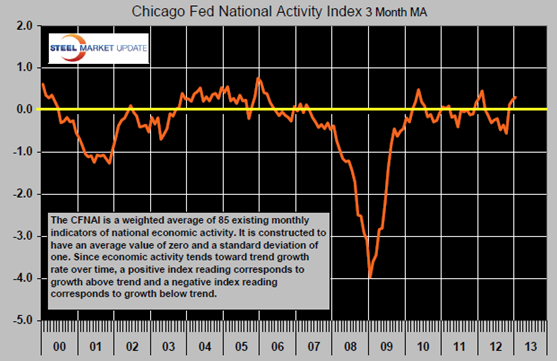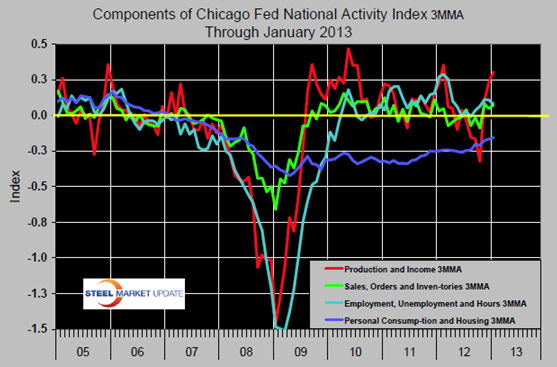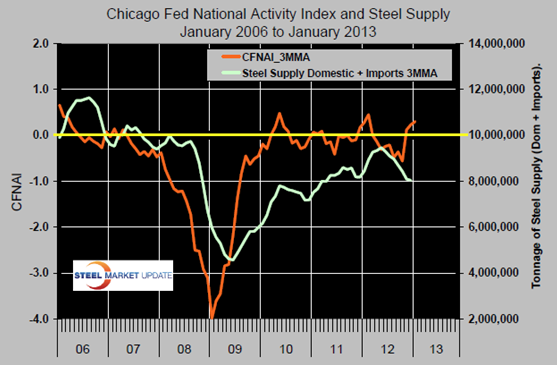Steel Products
Chicago Fed National Activity Index as Leading Indicator to Steel Supply
Written by John Packard
February 27, 2013
Written by: Peter Wright
Chicago Fed national Activity Index, (CFNAI) is a widely respected measure of both overall and detailed economic activity in the US. The index’s three-month moving average, increased to +0.30 in January from +0.23 in December. Given the substantial upward revisions for November and December, January’s result marked the third consecutive reading above zero, (Figure 1 below). Additionally, January’s reading suggests that growth in national economic activity was somewhat above its historical trend. The economic growth reflected in this level of the CFNAI suggests limited inflationary pressure from economic activity over the coming year.

The CFNAI is a weighted average of 85 monthly indicators of national economic activity. It is constructed to have an average value of zero and a standard deviation of one. Since economic activity tends toward trend growth rate over time, a positive index reading corresponds to growth above trend and a negative index reading corresponds to growth below trend.
The 85 economic indicators that are included in the CFNAI are drawn from four broad categories of data: production and income; employment, unemployment, and hours; personal consumption and housing; and sales, orders, and inventories. Each of these data series measures some aspect of overall macroeconomic activity. The derived index provides a single, summary measure of a factor common to these national economic data. On a three month moving average basis, production and income have increased strongly since September, personal consumption and housing has been improving steadily since mid 2011 (Figure 2 Below).

The CFNAI is a useful leading indicator of the apparent supply of all steel products with a lead of about six months, (Figure 3 below). The suggestion at present is that steel supply is below true market demand. It is well established that the volatility of steel supply is much greater than that of GDP. This is probably due to inventory control at all levels of the supply chain. Based on the first estimate of GDP in Q4 2012, economic activity shrank by 0.1 percent which by historical precedent would have led to a reduction of inventories nationwide. The second estimate of Q4 GDP growth will be released on Thursday this week. Based on revisions made to the growth of GDP in Q3 there may be a positive revision to the Q4 estimate. Stay tuned!


John Packard
Read more from John PackardLatest in Steel Products

Steel buyer spirits tempered by soft spot market conditions
Steel sheet buyers report feeling bogged down by the ongoing stresses of stagnant demand, news fatigue, tariff negotiations or implementation timelines, and persistent macroeconomic uncertainty.

CRU: US stainless prices to rise on expanded S232 tariffs
Stainless prices in the US market will rise, following price increases by major US producers. Our base case scenario incorporates higher US prices in the near term, despite the initial negative reaction by the market. US stainless prices will go up in 2025 H2 and will stay elevated in 2026 as tariffs on stainless […]

Galvanized steel demand unsteady amid lingering buyer fatigue: HARDI
Uneven demand for galvanized steel in June reflects a market that remains mired in uncertainty, according to industry sources.

OCTG industry salutes Customs for catching trade crooks
The US OCTG Manufacturers Association is commending US Customs for intercepting another Thai company's attempt to illegally transship Chinese oil pipe to the US.

Whirlpool says tariffs will bolster business
“Economically, the business case for products made in the us has become a lot more attractive," the CEO told Fox Business.
